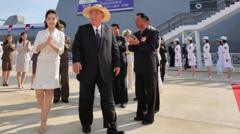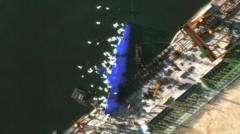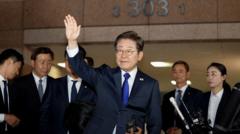Following an embarrassing capsizing incident during a warship launch, North Korean leader Kim Jong Un utilized the event to reframe the narrative, bolstering loyalty to his regime while signaling a shift in governance. This incident underscores North Korea's determination to enhance its naval capabilities and craft a more adaptive messaging strategy.
North Korea’s Warship Saga: A Lesson in Regime Resilience and Propaganda Strategy

North Korea’s Warship Saga: A Lesson in Regime Resilience and Propaganda Strategy
The capsizing and subsequent relaunching of North Korea’s new warship reveal insights into Kim Jong Un’s governance and propaganda tactics amidst ambitions for a nuclear-armed navy.
When North Korea's latest warship capsized during its launch last month, it sparked significant global interest. Despite no casualties and minor hull damage, the incident drew attention not for the mishap itself, but for Kim Jong Un's strong reaction. He condemned the failure as an "unacceptable criminal act" that could harm the nation’s dignity and ordered immediate repairs alongside arrests of four party officials.
This incident serves as a crucial insight into the North Korean regime's priorities and the ongoing emphasis on naval advancements. Kim, who prioritizes the development of a nuclear-armed navy despite an existing nuclear arsenal, has faced criticism over North Korea's historically weaker naval forces compared to rivals such as South Korea and the U.S.
Experts note that this warship, among two destroyers recently built, marks a significant step in Kim’s goal of modernizing North Korea's naval capabilities, aiming to position the country as a more formidable force on the ocean. The capsizing, particularly occurring while Kim was present, could have been seen as an embarrassing failure.
Yet, analysts argue that Kim's public expression of anger and his subsequent actions were part of a calculated political approach. Rachel Minyoung Lee from the Stimson Centre notes that revealing such failures represents a shift from the traditional regime strategy of concealing negative events. Instead, publicly addressing failures allows the leadership to present accountability and progress, an adaptation to the evolving information landscape within North Korea.
The swift repair and relaunch of the warship, completed in just over three weeks, transformed a potential embarrassment into a narrative of resilience. This adaptability not only showcased the regime's capabilities but also helped reinforce the loyalty of the citizens to the government and its objectives.
While discussing the incident, Kim praised a construction worker who had died during the project, transforming his death into a symbol of dedication to the cause, which highlights the regime's effort to foster a collective spirit of loyalty among the populace. This strategic use of propaganda reflects a departure from past practices under previous leaders, underscoring Kim's ability to refine the narrative as a method of governance.
As North Korea continues its quest for a nuclear navy, concerns linger regarding its capacity to operate globally and command respect on the world stage. Observers emphasize the need for vigilance against North Korea's growing military ambitions, reaffirming that the regime, even in perceived setbacks, is making strides toward its objectives. Kim's approach illustrates an evolving leadership style determined to showcase strength and progress on both the naval front and in shaping public perception.




















